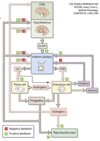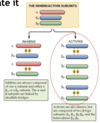Menstrual Cycle and Ovulation (Creamer) Flashcards
Schematic of the menstrual cycle hormonal changes:

Describe ovulation in terms of stages of meiosis:
- meiotic arrest (prophase I): elevated levels of cAMP; large antral follicles gain meiotic competence (stay is arrest until LH surge, can stay in this stage ~50 years)
- meiosis I finishes before ovulation: polar body 1 extruded
- meiotic arrest (metaphase II): elevated levels MAPK proteins
- resumption of meiosis II only at fertilization: rapid degradation of MAPK, polar body 2 extruded

What are the 3 phases of the ovarian cycle?
- follicular phase
- ovulatory phase
- luteal phase
- functional until of the ovary
- performs gametogenic and endocrine functions
- pre-menopausal cycling ovary contains follicular structures at many different stages
ovarian follicle

Describe the follicular phase of the ovarian cycle:
- the follicle selected for that particular month begins to grow
- follicular phase starts with the first day of your period and ends with ovulation
- each follicle houses a primary oocyte arrested in prophase I
- most developed Graafian follicle releases its oocyte during ovulation
- as that primary oocyte is released, it finishes its first meiotic division, becoming a secondary oocyte (arrested in metaphase II)

What are the steps of the follicular phase?
1) resting primordial follicle
2) growing preantral (primary and secondary) follicle
3) growing antral (tertiary) follicle
4) dominant (preovulatory, graafian) follicle
5) dominant follicle within periovulatory period
6) corpus luteum (of menstruation or of pregnancy)
7) atretic follicles

- primary oocyte arrested in prophase I (can remain for 50 years)
- surrounded by a single layer of pregranulosa cells
- release paracrine factors, no seroid hormones
- represents the ovarian reserve, of which most will undergo atresia (400-500 develop and ovulate)
primordial follicle

- central primary oocyte
- single layer of granulosa cells take on cuboidal shape
- increase in size of follicle due to growth of primary oocyte
- early production of secreted glycoproteins: ZP1, ZP2, ZP3, ZP4
primary follicle

- primary oocyte surrounded by 3-6 layers of cuboidal granulosa cells
- secretion of paracrine factors to induce local stromal cells to differentiate into thecal cells: inner glandular highly vascular theca interna, fibrous capsule-like theca externa
secondary follicle

How does progression into secondary follicle occur?
- involves increased vascularization
- migration from outer cortex to inner cortex, closer to ovarian vasculature
- follicles release angiogenic factors that induce development of 1-2 arterioles: generates vascular wreath around follicle
- zona pellucida development occurs: provides binding sites for sperm during fertilization
What type of hormonal signaling occurs during growth of preantral follicles?
- minimal endocrine function
- granulosa cells express FSH receptors, primarily dependent on paracrine factors from oocyte for growth
- granulosa cells do not produce ovarian hormones at this point
- thecal cells are analagous to testicular Leydig cells: express LH receptors, major product is androstenedione (although at this point production is minimal/absent)
Describe the antral phase of the follicular phase of the ovarian cycle of the menstrual cycle:
:)
- appearance of the antrum marks beginning of antral phase
- oocyte becomes suspended in fluid surrounded by a dense mass of granulosa cells (cumulus oophorus)
- two populations of granulosa cells develop: mural granulosa (stratum granulosum) and cumulus cells (cumulus oophorus/corona radiate)
- follicle growth becomes responsive to androgens during this phase
- oocytes grow rapidly during this stage, which slows in larger follicles
- oocyte becomes competent to complete meiosis I at ovulation: oocyte synthesizes sufficient amnts of cell cycle components (e.g. cyclin-dependent kinase 1, cyclin B); larger follicles gain meiotic competence but still maintain meiotic arrest until midcycle LH surge; meiotic arrest is maintained by elevated cAMP levels in mature oocyte)
- increase in follicular size depends on: increase in antral size, volume of follicular fluid, proliferation of granulosa cells

What are the 2 distinct granulosa cell populations that develop during the antral phase of follicular development?
(100-fold increase in granulosa cells occurs)
- mural granulosa (stratum granulosum): outer wall of follicle, become highly steroidogenic
- cumulus cells (cumulus oophorus/corona radiata): maintain gap and adhesion junctions w/ oocyte; released during ovulation w/ oocyte
When does follicle growth become responsive to gonadotropins?
- during the antral follicle growth phase
- theca interna - LH: synthesize androgens from acetate and cholesterol; androstenedione is major steroid product; limited estrogen synthesis
- granulosa - FSH: convert androgens from thecal cells (granulosa-mediated aromatization of androgens to estrogens, stimulated by FSH); induces expression of LH receptors late in follicular phase

How does FSH play a role in selection for follicle for ovulation?
- several large antral follicles are recruited to begin development each monthly cycle
- selection of 1 dominant follicle occurs early in follicular phase
- mural granulosa produce low levels of estrogen and inhibin B
- FSH levels decline: largest follicle w/ most FSH receptors (highest sensitivity) becomes dominant follicle; other follicles undergo atresia (apoptosis of oocytes and granulosa cells)
- midcyle, dominant follicle becomes a large preovulatory follicle (Graffian follicle)

















